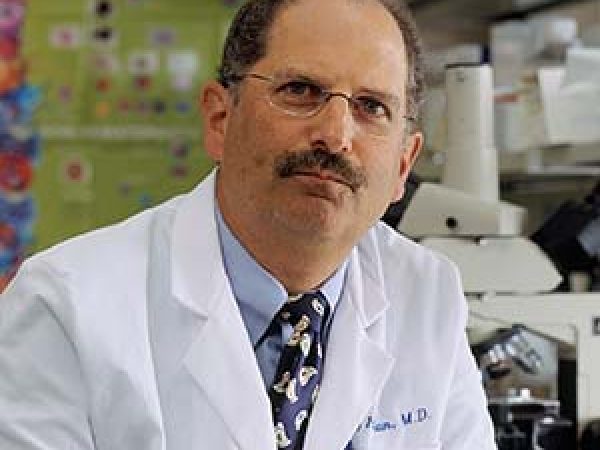AACR Annual Meeting 2023: Opening Plenary Covers Breadth of Cancer Research
“Are you ready to have a great meeting?” Robert Vonderheide, MD, DPhil, asked the nearly 11,000 attendees gathered in the plenary hall and virtually to watch the Opening Plenary Session of the AACR Annual Meeting 2023. Vonderheide was the Program Committee Chair of this year’s Annual Meeting.
“Over the course of the next four days, you will hear about the hottest topics and advances from basic cancer breakthroughs to late-breaking clinical trials, and so much more.” he continued.
The Opening Plenary Session: Advancing the Frontiers of Cancer Science and Medicine reflected the theme of this year’s meeting, and highlighted the breadth of cancer research included in this year’s scientific program—from health care access and early detection to basic and clinical advances in understanding and treating cancer.
According to Vonderheide, the session illustrated how studies across the continuum of cancer research are advancing progress and creating new frontiers for researchers to explore.
“I hope with its intentional diversity in all aspects, the scientific program will challenge all of you to take risks, open your minds, cultivate a spirit of adventure,” he said.
Progress and challenges for early cancer detection
The first presentation was delivered by Deborah Schrag, MD, MPH, a medical oncologist and the Chair of Medicine at Memorial Sloan Kettering Cancer Center. She discussed recent progress in multi-cancer early detection (MCED) tests and the ongoing challenges faced by the field.
Early detection of cancer is crucial to improving patient outcomes, since early-stage cancers are typically easier to treat. However, screening strategies are not yet available for some of the deadliest cancers, such as pancreatic and stomach cancers. To address this issue, researchers are developing and testing various MCED tests that look for signs of cancer in easily attainable patient samples.
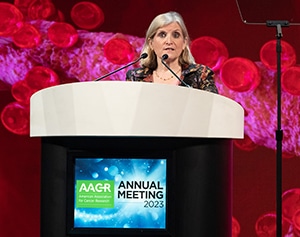
“MCED tests use different molecular methods and combinations of methods to detect cancer from a biospecimen, usually blood, before a tumor becomes symptomatic or lethal,” Schrag explained.
She shared data from the prospective PATHFINDER clinical trial, which evaluated the clinical utility of a MCED test developed by GRAIL Inc. to detect signs of cancer in blood samples. Of the 6,621 individuals enrolled in the trial, 3,681 had a high risk of cancer, defined as having a cancer-associated genetic predisposition, a personal history of cancer, and/or a history of smoking. The MCED test identified potential signs of cancer in 92 patients, similarly split between those with high risk and low risk of cancer. Thirty-five of these patients went on to be diagnosed with cancer, for a positive predictive value of 38%. A modified version of this test, with a positive predictive value of 43%, is now commercially available.
While early detection is important, a key metric for determining the value of an MCED test will be how many lives are ultimately saved. “We can increase incidence without moving the needle on mortality,” Schrag noted, referring to the overdiagnosis of slow-progressing cancers.
She added that it will be important to avoid lead time bias (the artificial inflation of survival length due to the earlier detection of cancer) when assessing survival. Additional priorities include addressing logistical challenges of the FDA approval process, expanding insurance coverage, and providing equitable access to MCED tests.
“MCED technologies have the potential to transform screening and health care delivery,” Schrag concluded. “At the same time, we need to avoid perils. We must conduct rigorous randomized trials and include rigor in study design or we will not know whether these tests are effective, and we will sow confusion [with] adverse consequences for public health.”
Pushing immunotherapy forward
David DeNardo, PhD, a professor at the Washington University School of Medicine in St. Louis, started his lecture with an encouraging statistic: 1 of every 5 patients in the U.S. with advanced cancer now receives immunotherapy.
“What an exciting time it is to study immuno-oncology and immunology in cancer,” he said. “Even more exciting is the number of different opportunities for immunotherapy,” including cancer vaccines, T-cell therapies, and immune checkpoint inhibitors.
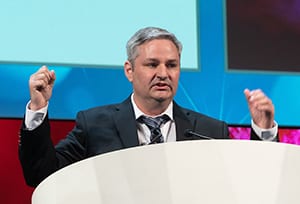
Despite recent strides in immunotherapy, the lack of response in some cancer types is an enduring challenge. DeNardo suggested modulating local and systemic components of the immune system as a strategy to improve treatment responses. In addition, he noted that efforts should account for the distinct immune environments of different organs. Pancreatic tumors, for example, have a 100-fold lower number of dendritic cells compared with lung tumors, making pancreatic tumors less immunologically active.
To combat this barrier, DeNardo examined the impact of systemic and local interventions to boost dendritic cell function in mouse models of pancreatic cancer. The approach involved the systemic delivery of the FLT3 ligand to mobilize precursors of dendritic cells and the local activity of a CD40 agonist to activate dendritic cells in the tumor microenvironment. In mouse models and in patients, this strategy led to greater infiltration of immune cells in pancreatic tumors and enhanced T-cell activity.
“It worked remarkably well,” DeNardo said, noting that the results highlight the value in understanding differences between organs and leveraging local and systemic immunity to overcome challenges associated with these differences.
“How do we leverage what we discover [about different cancer types] and apply that to the clinical scenario?” DeNardo posed. “This is the challenge I put to all of you.”
Understanding cancer cachexia
A common yet understudied aspect of the cancer experience is cachexia, according to Teresa Zimmers, PhD, a professor at Oregon Health & Science University. This symptom is characterized by tumor-induced tissue wasting, weight loss, and abnormal immune responses, Zimmers explained.
Despite its prevalence, the molecular causes of cachexia remain unclear, but cancer-induced effects on muscle growth, metabolism, and protein synthesis could contribute. Recent studies presented by Zimmers suggest that the cytokine IL-6 might also play a role.
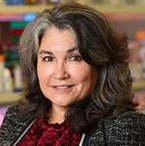
She added that cachexia adversely impacts responses to anticancer therapies, such as chemotherapy, surgery, and immunotherapy, and correlates with tumor aggressiveness and patient outcomes.
“Cancer causes cachexia, but cachexia promotes cancer,” Zimmers summarized.
She then turned to discussing potential treatments for this condition, sharing preclinical data that suggest that existing chemotherapeutics might be effective against cachexia. In addition, she noted that the treatment of cachexia may require sex-specific approaches, as gene expression data from patients with pancreatic cancer suggested sexual dimorphism in the expression of various muscle genes.
“Through treating cachexia, we can improve quality of life, length of life, and chance of cure,” said Zimmers.
Treating cancer in patients with HIV
The advent of antiretroviral therapy dramatically reduced deaths from AIDS, and with it, deaths from AIDS-related cancers dropped, too. But, as explained by Robert Yarchoan, MD, the incidence of non-AIDS-related cancers has risen in patients with HIV, likely due to longer survival.
Cancer is now the most frequent cause of death in people with HIV, said Yarchoan, who is the director of the Office of HIV and AIDS Malignancy at the National Cancer Institute.
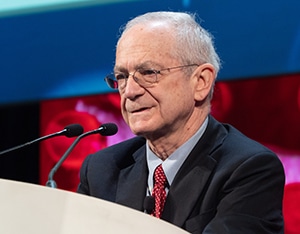
And while immunotherapy is increasingly used to treat cancers, many physicians remain reluctant to use it to treat patients with HIV due to concerns about safety, lack of efficacy due to HIV’s impact on T cells, and the potential for reactivation of latent HIV.
However, research from Yarchoan and others indicates that these concerns are largely unfounded.
“In fact, viral pathogenesis makes [immunotherapy] particularly worth considering in HIV-associated tumors since viruses are neoantigens that can be targeted,” he said.
Like cancers, viruses employ mechanisms to evade immune recognition. Kaposi sarcoma-associated herpesvirus (KSHV), a virus that is common among patients with HIV, degrades various cell surface immune markers to accomplish this.
Yarchoan shared data demonstrating that the angiogenesis inhibitor pomalidomide (Pomalyst) can increase immunogenicity by reversing this viral effect. Early clinical trial results suggest that pomalidomide with immunotherapy may be an effective treatment for KSHV-positive, HIV-positive patients with relapsed/refractory lymphoma.
Additional findings reported by Yarchoan indicate that KSHV also increases the expression of the IL-6 and IL-10 cytokines in Kaposi sarcoma and Castleman disease, conditions that are prevalent among patients with HIV. He showed that the immune modulator pacritinib (Vonjo) blocked this upregulation in cell lines and shared that this approach will be evaluated in an upcoming clinical trial.
A call to action to address inequities in cancer care
Tomi Akinyemiju, PhD, an associate professor at Duke University School of Medicine, closed the Opening Plenary Session by discussing inequity in cancer care.
She shared several anecdotes illustrating the financial, cultural, language, and logistical barriers faced by patients when navigating cancer care. In one example, Jodi, a patient diagnosed with advanced lung cancer, experienced challenges in several steps of her care: limited access to transportation, language barriers, financial burdens, lack of accommodation and care coordination, and poor experiences with her providers.
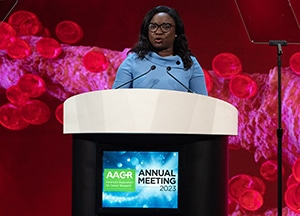
“Jodi’s story is not unique,” said Akinyemiju. “Too many patients experience barriers that prevent them from receiving lifesaving cancer care. For Black, Hispanic, and non-white patients, these challenges are compounded by orders of magnitude.”
Added challenges for non-white patients may include fears of deportation if they or their family members are undocumented, a lack of trust in physicians due to a history of medical racism, and unconscious biases among their providers, Akinyemiju explained.
She noted that current efforts to tackle inequities are hindered by limited data on non-white patients, a lack of diversity in the research and medical workforce, and an oversimplification of the problem.
“Too often, we fail to acknowledge the complex biological and social drivers of disparities. Race is a powerful proxy for biological, social, and psychological factors that shape the disease,” she said.
“As we advance the frontiers of cancer science and medicine, we must center equity across the entire translational spectrum,” she added.
Akinyemiju issued a call to action to all attendees to take it upon themselves to combat inequity by asking the tough questions, seeking guidance, and coming up with solutions.
“We are collectively responsible for the current state of affairs, and we all have a role to play,” she said. She cautioned that “if equity gaps persist, we will fail to end cancer as we know it.”

